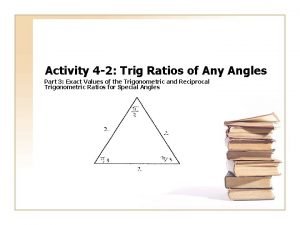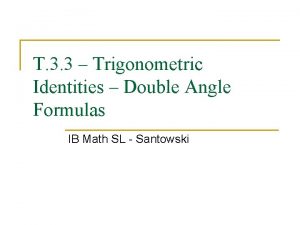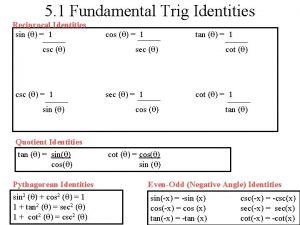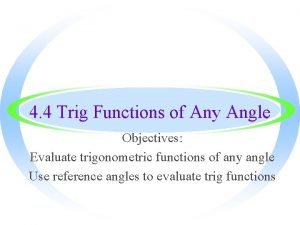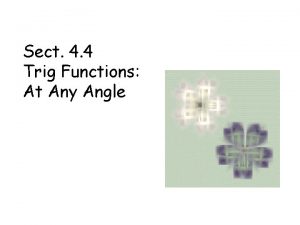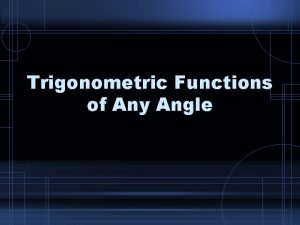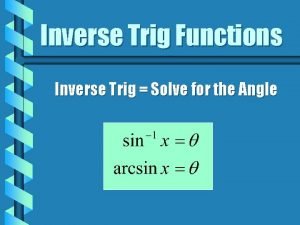4 4 Trig Functions of any Angle I





- Slides: 5

4. 4 Trig Functions of any Angle I. Definitions of Trigonometric Functions. A) B) C) 1) opp = opposite side, adj = adjacent side.

4. 4 Trig Functions of any Angle II. Pythagorean Theorem and Trig Functions. A) a 2 + b 2 = c 2 for any right triangle. 1) If you know the (x , y) coordinates then you have the “a” and “b” terms in the Pyth thm. 2) The “a” (or “b”) term is the x (or y) coordinate, and the other letter is the other coordinate. 3) The “c” term is the hypotenuse [the “r” in the trig] B) If you know the coordinates for a given angle, you can use the Pythgorean theorem to find the hypotenuse (the r). 1) Now you can write all the trig functions using x, y, & r.

4. 4 Trig Functions of any Angle III. Evaluating Trigonometric Functions. A) sine, cosine, and tangent have different signs in different quadrants. 1) Because the (x , y) points have different signs. 2) Quad II sin θ = + cos θ = tan θ = - Quad I sin θ = + cos θ = + tan θ = + Quad III sin θ = cos θ = tan θ = + Quad IV sin θ = cos θ = + tan θ = -

4. 4 Trig Functions of any Angle IV. Finding the Reference Angle & Using a Calculator. A) Let θ be any angle in standard position. Its reference angle is the acute angle θ’ formed by the terminal side of θ and the horizontal axis (the x-axis). B) Finding the reference angle. [Quadrant I = no change] 1) Quadrant II = π – θ (rad) or 180° – θ (deg) 2) Quadrant III = θ – π (rad) or θ – 180° (deg) 3) Quadrant IV = 2π – θ (rad) or 360° – θ (deg)

4. 4 Trig Functions of any Angle IV. Finding the Reference Angle & Using a Calculator. C) Using a calculator to evaluate trig functions. 1) You have to change the MODE to whatever type of angle measurements you are using (degrees / radians) 2) To find cosecant, and cot, use the x– 1 button. Examples: a) To evaluate sin (30°) use degree mode (answer =. 5) b) To evaluate cos (2π/3) use radian mode (answer = –. 5) c) To evaluate tan (-4) use radian mode (answer = – 1. 158) d) To evaluate cot (410°) type tan(410°)– 1 (answer =. 839) HW: page 318 #1– 87 every other odd problem (1, 5, 9, 13 …)
